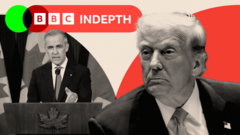Amid an era of escalating tensions, Machias Seal Island serves as a contentious backdrop to the complicated relationship between the US and Canada. This tiny but strategically significant rock in the Gulf of Maine, long claimed by both nations, lies at the heart of what is known as the “Grey Zone”—a location fraught with a historical dispute that has persisted since the 1700s.
Fishermen on both sides have faced ongoing dangers here, risking injury and even loss of body parts while competing fiercely during lobster season, driven largely by the question of which nation has the rights to the area’s resources. John Drouin, a veteran lobsterman, recalls the chaotic battles over traps, hinting at not only the physical dangers but also the emotional toll on local communities.
Despite a historical connection—bolstered by an international court ruling in 1984 granting fishing rights to both countries—the relationship has soured recently due to President Trump's rhetoric. Statements suggesting Canada could become the “51st state” and proposing tariffs have sparked reactions ranging from fear to defiance among Canadians.
The situational backdrop of Cutler, Maine, illustrates the larger stakes involved in the “Lobster Wars,” pitting fishermen against each other in fierce competition as they navigate parallel lines of economic survival and national sovereignty claims. As protests against US tariffs grow, sentiments are changing in Canada where calls for a boycott against American products gain traction.
The broader geopolitical context transforms the discourse further. Trump’s perceived desire for Canadian resources—be it minerals or water—deepens fears among Canadian leaders that the ultimate goal may be more than trade relations. Reports have emerged of Canadian Prime Minister Justin Trudeau questioning Trump’s intentions, suggesting fears of annexation and economic coercion that threaten the very fabric of Canada’s independence.
Adding to the complexity, historical perspectives are resurfacing, reminding citizens of times when military intervention was sought against Canadian territories in the 1800s, now seen as echoes of a bygone era. Encountering such claims, Canada seems to brace for a turbulent future rather than a cooperative coexistence. As leaders engage in dialogues marred by mistrust, there’s a palpable sense that Canada will not acquiesce to threats—drawing renewed lines in the sand while preparing to defend vital national interests.
The diplomatic fallout is sure to have lasting consequences for trade, tourism, and international partnerships, casting a shadow over what was once a strong alliance. As uncertainty looms and historical grievances resurface, the question remains: can trust be rebuilt, or are both nations hurtling towards a confrontation that could reshape North America’s geopolitical landscape?

















